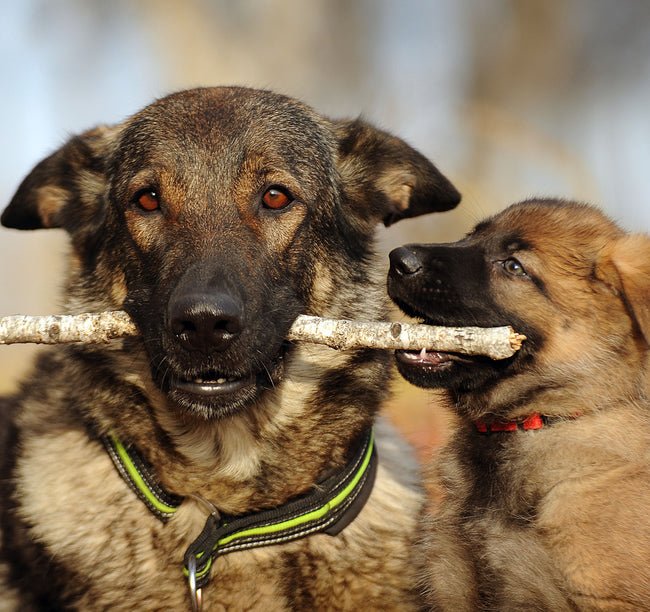![]() Listen to the Podcast
Listen to the Podcast
Dogs are a bit like potato chips - it can be very hard to have just one! Adding a second dog to the family can be a joy. It's double the fun, but also double the work. There are some unique challenges and common mistakes that come along with adding a second dog to your home. Here are some tips to ensure you aren't making them!
Second Dog Syndrome
In dogdom, there's a turn of phrase called, "Second Dog Syndrome". This describes the process of adding another dog to the home quite well, but not necessarily in a positive light. As humans, we are bound to forget all of the time and effort it takes to raise a puppy right. All too often, a second dog joins the household and the expectation is that they will behave as the existing dog in the home does, so they are often given the same freedom right off the bat. The truth is, every new dog is a completely blank slate. Thinking they can keep up with your existing dog in terms of understanding will set you up for a lot of frustration down the road.
That new puppy will come without the benefit of experience that your other dog has had. Don't get caught expecting the new puppy to be perfect. Remember all of the work you put into your other dog - the new puppy will need the same time, effort and consistency as they grow.
One-on-One Time
This is tricky as it's usually very rewarding to watch your new puppy and your older dog hanging out and enjoying their time together, but when you bring home a new pup, it's crucial that they don't spend all of their time with the older dog. It's far too easy for dogs to bond to one-another and allowing them to spend all of their time together will have the humans left out of the equation. Eventually, the bond could be so dangerously close that the pup has a hard time functioning in normal life without the older dog present.
Make sure you plan to separate the puppy and the older dog for the majority of the time. This will give the new pup a chance to bond to the humans in the home and it will also provide training time for the new pup. Puppies have limited energy in the early days, so providing them with quality time rather than quantity time is an important tactic. When I have a youngster in the home, I bring them out when I can give them 100% of my focus. I use this time to bond, train, play with, etc. Once I've spend 20 minutes to 1/2 an hour with the pup, they're usually ready for another nap.
While you're spending this time with the pup, it's always nice to give the older dog something special to do. Maybe a Kong stuffed with their favourite things or a bone they only get when you're spending one-on-one time with the pup. That way, you're less likely to see frustration from the older dog who will likely want to be part of the fun.
While you are planning individual time with the pup, make sure you set aside some individual time for the older dog too. You'll want to continue to harbour a relationship with them as well. Have a plan for something fun to do with the older dog - whether it's a class you take together or just making sure you have individual walks or trick training sessions, it's always good to keep the bond with your older dog strong as well.
Don't Put Your Other Dog's Out
Often, people expect their dogs to be overly tolerant of a puppy and they allow the pup to constantly harass the older dog. This is a dangerous scene. Most older dogs will be tolerant to a point, but they all have their limitations. Don't let the puppy push your adult dog to that point. People often see the pup being pushy and either want the older dog to be more tolerant or they expect the older dog to put the youngster in their place. Wanting the older dog to discipline your puppy is not a good tactic. Discipline, when necessary, should come from the humans in the household. Don't feed the frustration and resentment that will be created in your older dog. Advocate for the adult dog, not just the puppy. Remember that their life has changed too.
Supervise consistently and intervene often when you allow the dogs time together. Make sure you check in on your older dog's comfort level, especially if the puppy is nipping or likes to bounce and bark at the older dog. A good way to do this is to remove the puppy and see what the older dog does. If the older dog continues to try to interact with the puppy, great - they're still enjoying the puppy. If they do not seek the puppy out when you remove them, they're not enjoying the interaction. Step in early - don't wait until they've been pushed to their limit.
Bringing another dog into the house is a wonderful experience - with a few management tips and some sweat equity, they'll fit into the household well!
As always, Happy Training!

